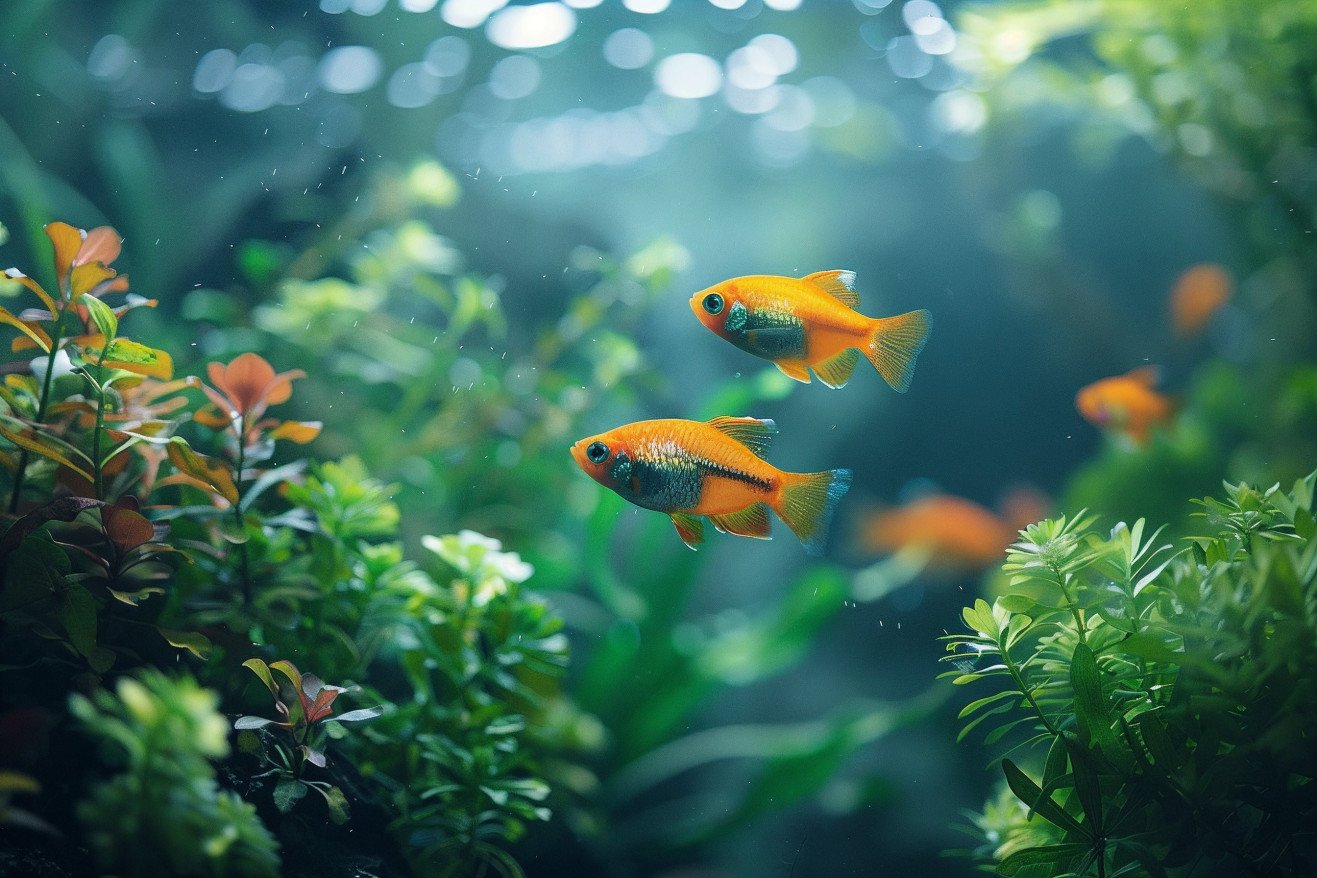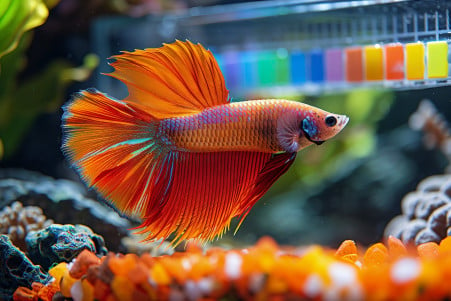Can Aquariums Reduce Nitrates? Exploring Effective Strategies
26 March 2024 • Updated 25 March 2024

It's important to keep nitrate levels low in your aquarium for the health of your fish, and there are several ways to do it, including water changes, live plants, and chemical filter media. Partial water changes (20-25% weekly) are the most effective way to lower nitrates. Live plants consume nitrates and are an important part of the nitrogen cycle. Chemical filter media, such as Purigen, can also be used to absorb nitrates, and water testing kits will help you keep an eye on your levels and make changes before they get too high.
You don't have to struggle to keep your water chemistry in check. In the sections below, we'll cover a number of methods that have been tested in the aquarium hobby and are supported by science that can help you reduce and control nitrate levels naturally over time. Whether you have a freshwater community tank or a saltwater reef tank, you'll find ways to make sure this important parameter stays in the right range for your fish's health in the long run.
How can you reduce nitrates in a fish tank?
Water Change Techniques That Work for Nitrate Reduction
One of the most effective ways to lower nitrate in an aquarium is through regular water changes. The Spruce Pets notes that performing weekly 20-25% water changes will help dilute and remove the nitrates that have built up in the tank. If you have a high bioload or high-nitrate tank, increasing the frequency or percentage of water changes can help you lower nitrates faster.
When you're doing water changes, make sure to use a gravel vacuum to remove detritus and other organic waste that can contribute to nitrate levels. Swell UK also recommends testing your tap water for nitrates and using reverse osmosis (RO) or deionized water to avoid adding nitrates to your tank during water changes. You should also make sure to keep a regular schedule and log your water changes so that you can see if there are any patterns that emerge over time.
If you have a heavily planted tank, the live plants in the tank will help absorb some of the nitrates, which brings us to the next section about using aquatic plants to help control nitrates naturally. Regular water changes and testing will also help you keep your water parameters stable, which is good for both your fish and your plants.
Using Live Plants to Absorb Nitrates
Some fast-growing aquarium plants can absorb and use nitrates as nutrients, which makes them great for keeping nitrate levels in check. The Aquarium Plants Forum lists stem plants like water wisteria, hornwort, and anacharis, and floating plants like duckweed and water lettuce as some of the best plants for nitrate reduction. These plants will quickly take up nitrates from the water column.
Rooted plants with high nutrient requirements, like java fern, anubias, and cryptocoryne, can also help by taking up nitrates from the substrate. Modest Fish suggests keeping a well-planted tank with a mix of these nitrate-absorbing plants for the best results. Make sure to provide the right lighting, fertilization, and even CO2 to help your plants grow and absorb nitrates.
Regularly trimming and thinning plant growth is also necessary, as The Planted Tank Forum notes, to encourage new growth and maintain the plants' ability to absorb nitrates. By creating a healthy planted tank, aquarists can take advantage of the natural nitrate-reducing power of aquatic plants.
Chemical Filter Media and Nitrate Removers
Chemical filter media and additives can also help lower nitrates in your tank. Swell UK explains that chemical filter media, such as Purigen, can remove nitrates from the water column. Nitrate-removing resins, pads, and sponges can also be used in combination with biological filtration to further reduce nitrate levels.
Make sure to use chemical media as directed by the manufacturer and replace it as often as recommended. PetMD suggests the Deep Blue Professional nitrate reducer filter media pad. Liquid nitrate removers can help lower nitrate levels in the short term, but they're not a substitute for regular maintenance and water changes.
To achieve the best nitrate control, CerMedia recommends a combination of chemical and biological filtration. This way, the tank can benefit from the immediate nitrate reduction of chemical media and the long-term nitrogen cycle management of a healthy biofilter.
How to Cycle a Fish Tank
The nitrogen cycle is the biological process that turns fish waste into nitrates in an aquarium. Per The Spruce Pets, the cycle is a series of steps that continually break down nitrogenous compounds, starting with ammonia and ending with nitrate. The cycle must be established and maintained to control the three main biological toxins - ammonia, nitrite, and nitrate - that are produced in a closed aquarium.
Cycling a new tank is the most important step in setting up the nitrogen cycle. Fresh Water Systems notes that this process usually takes between 4-8 weeks and requires the constant monitoring of ammonia, nitrite, and nitrate levels. API Fish Care recommends adding fish slowly in small numbers to keep ammonia levels low and allow the beneficial bacteria to grow.
It's also important to maintain a healthy tank environment, which includes appropriate fish levels, feeding, and biological filtration, to prevent nitrates from reaching dangerous levels. The Spruce Pets warns that fish and other tank inhabitants can be stressed or killed by sudden increases or decreases in nitrate levels. However, with a good understanding of the nitrogen cycle, you can manage your tank to create a safe and healthy environment for your fish.
How to Prevent Nitrates
Preventing nitrates from building up in the first place is important to keep your aquarium healthy and balanced. Per Seahorse.com, the amount of nitrate that builds up is directly related to the balance between nitrification (which creates nitrate) and denitrification (which removes nitrate).
You can help prevent nitrate buildup by not overstocking your tank with too many fish and not overfeeding them. The Spruce Pets also notes that regular tank maintenance, including substrate vacuuming and filter cleaning, can help remove detritus and organic matter that contribute to nitrate buildup.
In addition, using high-quality source water that is free of nitrates or installing a reverse osmosis (RO) system can help prevent nitrates from being added during water changes. Per The Spruce Pets, tap water can contain nitrates up to 40 ppm, so it's important to test the source water and use RO or deionized water if necessary.
To ensure a well-rounded approach to nitrate control, it's important to maintain a healthy balance of live plants, biological filtration, and regular water changes. Seahorse.com suggests adding live rock, a deep sand bed, and fast-growing macroalgae to help reduce nitrates. Regularly monitoring water quality and taking steps to prevent nitrate levels from rising can help you avoid potential problems for your aquarium's inhabitants.
Conclusion: How to Balance Your Aquarium's Nitrate Levels
Keeping nitrate levels low and stable is important for the overall health and happiness of your aquarium's inhabitants. To keep nitrate levels in check, it's best to use a combination of regular water changes, live plants, chemical filtration, and good aquarium maintenance. Regular water testing and a good understanding of the nitrogen cycle are also important to make sure you can keep nitrate levels where you want them.
There are also steps you can take to prevent nitrate levels from getting too high in the first place, such as making sure you don't overstock your tank or overfeed your fish. With time and effort, you can create an environment that's perfect for your fish and plants.


